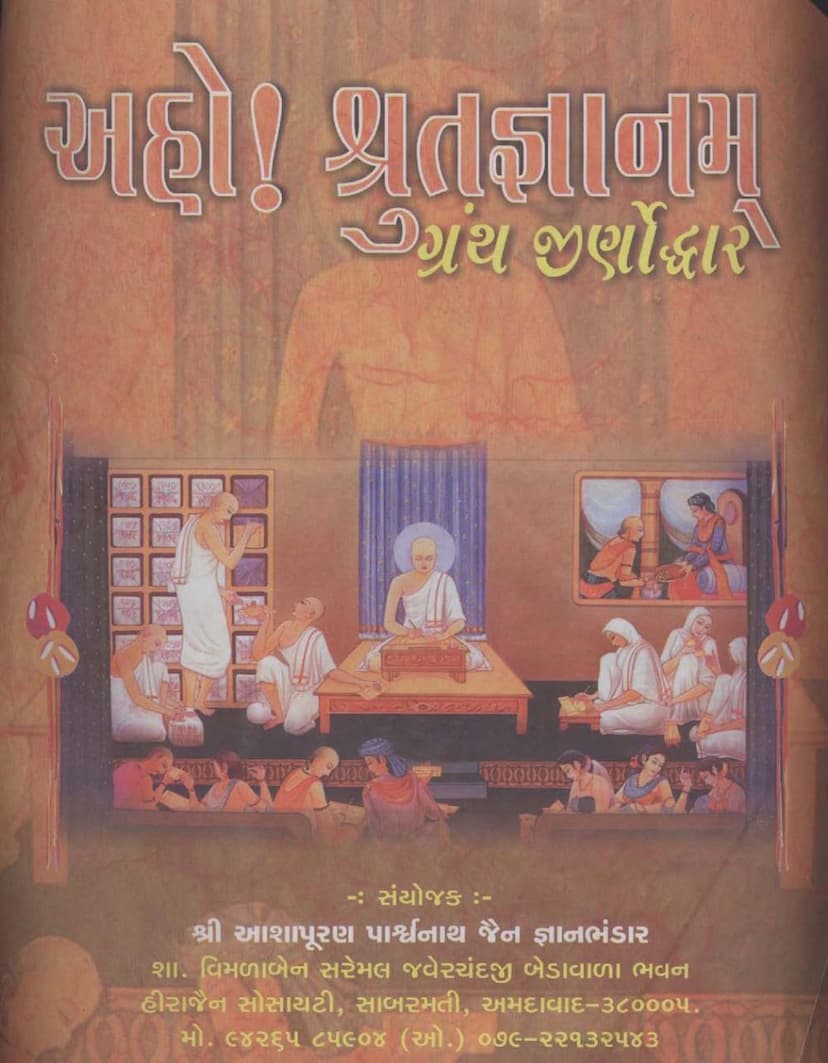Prachin Jain Lekh Sangraha Part 1
Added to library: September 2, 2025

Summary
This document is the first volume of "Prachin Jain Lekh Sangraha" (Collection of Ancient Jain Inscriptions), compiled and edited by Muni Jinvijay. Published by Atmanand Jain Sabha, this book is part of a larger initiative to preserve and make accessible rare and ancient Jain texts.
Here's a breakdown of the content:
Key Information & Purpose:
- Title: Prachin Jain Lekh Sangraha Part 1 (Ancient Jain Inscriptions Collection Part 1)
- Author/Editor: Muni Jinvijay
- Publisher: Atmanand Jain Sabha
- Catalog Link: https://jainqq.org/explore/009685/1
- Initiative: The book is part of the "Aho Shrut Gyanam" (Oh, the Knowledge of Scripture!) text restoration project. It aims to digitize and preserve rare Jain manuscripts and publications that are otherwise difficult to access.
- Target Audience: Scholars, researchers, and individuals interested in Jain history, religion, art, and inscriptions.
- Availability: The digitized versions are available for private and personal use and can be downloaded from websites.
Content Overview (Based on the provided pages):
The initial pages (1-3) are introductory, acknowledging sponsors and the project's goal. Page 4 onwards presents a catalog of restored and digitized books, categorized into sets:
- Set No. 1 (Pages 4-5): Lists 54 books, primarily focusing on Jain scriptures, commentaries, and philosophical treatises. It also includes significant works on architecture, sculpture, and arts, such as various "Shilpa Shastra" (Arts and Crafts) texts and texts related to Vastu Shastra (architecture). Notable authors include Muni Jinvijay, various Acharyas, and scholars like B. Bhattacharya and Shri Prabhashankar Oghadbhai.
- Set No. 2 (Page 6): Lists 18 books, continuing the theme with scriptures, historical texts, and works on Jain culture, music, and iconography.
- Set No. 3 (Pages 7-8): Lists 23 books, covering Jain literature, history, art, and inscriptions, including collections of Jain inscriptions from various regions.
- Set No. 4 (Pages 8-9): Lists a further 18 books, continuing the catalog and including more works on Jain literature, history, and inscriptions.
Detailed Content of the Introduction and Main Text (Pages 10-116):
The core of the provided text (starting from page 10) is the detailed presentation and analysis of ancient Jain inscriptions, specifically focusing on the Hathigumpha inscription at Udayagiri Caves near Cuttack, Odisha.
- Significance of the Hathigumpha Inscription: The text emphasizes that this inscription, dating back to King Kharavela, is the most ancient Jain inscription found to date. It sheds invaluable light on the past glory of Jainism and provides the earliest epigraphic mention of a Jain king (Kharavela). It is considered crucial not only for Jain history but also for the political history of ancient India.
- Historical Context: The introduction discusses the challenges of relying solely on Jain scriptures for historical verification, as many were written much later and can contain exaggerations. It highlights the greater authenticity attributed to inscriptions, as they document events closer to the time they occurred.
- Location and Description of the Caves: The text provides a geographical introduction to the Udayagiri and Khandagiri hills in Odisha, detailing their location relative to Cuttack and Bhubaneswar. It describes the numerous rock-cut caves (guphas) on these hills, noting their architectural features, dimensions, and the artistry of the carvings. It mentions that some caves are attributed to both Jain and Buddhist monks.
- Jain Caves and Iconography: The text specifically discusses caves with clear Jain influence, such as Navamuni Gupha, and describes the iconography found in them, including sculptures of Tirthankaras, their symbols, and decorative motifs. It notes the distinct characteristics of Jain cave art and mentions the debate surrounding the dating and attribution of these caves.
- Chronology and Dating: The difficulty in precisely dating the caves and inscriptions is highlighted, with different scholars proposing various dates based on script, artistic style, and inscription content. The text mentions the Hathigumpha inscription's estimated date, ranging from the 2nd century BCE to potentially earlier periods.
- The Hathigumpha Inscription's Content: A significant portion of the document is dedicated to the detailed analysis and translation of the Hathigumpha inscription.
- Discovery and Early Research: It mentions early explorers like E. Stirling and Kittoe, and the scholarly efforts of James Prinsep and Dr. Rajendralal Mitra in deciphering and translating the inscription.
- Decipherment and Interpretation: The text critically examines the translations and interpretations of various scholars, particularly highlighting the significant contributions of Pandit Bhagwanlal Indrajī in accurately identifying the language and context of the inscription. It also acknowledges the further clarification provided by Shri Keshavlal Harshadray Dhruv.
- Kharavela's Reign and Achievements: The inscription is presented as a chronicle of King Kharavela's life and reign. It details his lineage, his early life, his coronation, and his extensive public works, military campaigns, and religious patronage.
- Key Historical Details from the Inscription:
- Kharavela's lineage as a descendant of the Cheta dynasty and his reign over Kalinga.
- His military expeditions across India, including victories over rulers of Magadha, and his defeat of Pushyamitra Shunga.
- His respect for Jainism, evidenced by his bringing back of a Jain idol that had been taken away by a previous ruler (Nanda King).
- His patronage of Jain monks and the construction of caves for their residence.
- His extensive public works, including repairing city walls, building water reservoirs, and renovating temples.
- His participation in religious festivals and his adherence to Jain principles.
- Linguistic and Paleographic Analysis: The text discusses the script of the inscription, comparing it to other ancient Indian scripts, and analyzes the Prakrit language used.
- Debates and Scholarly Contributions: It highlights the ongoing scholarly discussions and differing interpretations of the inscription, particularly regarding its dating and the identity of the rulers mentioned.
Overall Goal:
The "Prachin Jain Lekh Sangraha" aims to be a comprehensive repository of Jain inscriptions and ancient texts, ensuring that this valuable historical and religious heritage is preserved for future generations. This first volume specifically focuses on foundational Jain inscriptions, particularly the crucial Hathigumpha inscription, providing a deep dive into its historical, linguistic, and religious significance.